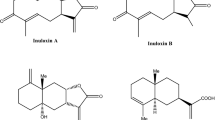Abstract
Callus and micropropagated shoots were initiated from leaf explants of the neem tree, Azadirachta indica A. Juss. A variety of whole plant and in vitro cell cultures from neem seedlings of Ghanian origin were tested for insect antifeedant compounds using the desert locust (Schistocerca gregaria (Forskål)). Feeding suppression occurred when whole extracts of seed, leaf, callus, suspension and shoot cultures were tested in no-choice feeding bioassays. Controls of sucrose, carrot callus and the plant growth medium showed no feeding deterrence. Azadirachtin, the main known antifeedant in neem seed kernels, was quantified from a seed extract by HPLC but was not detected in any of the other extracts. Antifeedancy was determined during batch growth of a suspension culture which had been in culture for 5 months; results indicated that antifeedants were still being formed and that levels increased after maximum biomass was attained.
Similar content being viewed by others
References
Govindachari TR, Sandhya G & Ganeshraj SP (1990) Simple method for the isolation of azadirachtin by preparative HPLC. J. Chromat. 513: 389–391
Lewis AC & van Emden HF (1986) Assays for insect feeding. In: Miller KR & Miller TA (Ed) Insect-Plant Interactions (pp 95–119). Springer Verlag, New York
Mordue(Luntz) A J & Blackwell A (1993) Azadirachtin: An Update. J. Insect Physiol. 39: 903–942
Mordue(Luntz) A J & Nasiruddin M (1992) Azadirachtin treatment and host plant selection. In: Menken SBJ, Visser JH & Harrewijn P (Eds) Insect—Plant Relationships, Proceedings of the Eighth Symposium (pp 176–178). Kluwer Academic Publications, Dordrecht, The Netherlands
Murashige T & Skoog F (1962) A revised medium for rapid growth and bioassays with tobacco cultures. Physiol. Plant 15: 473–479
Nasiruddin M (1993) The effects of azadirachtin and analogues upon feeding and development in locusts. PhD thesis, University of Aberdeen
National Research Council (1992) Neem: A Tree for Solving Global Problems. National Academy Press, Washington DC
Ramesh K & Padhya MA (1988) Isolation of nimbin from Azadirachta indica leaves and its callus cultures. Indian Drugs 25 (12): 526–527
Saxena RC (1989) Insecticides from neem. In: Arnason J T, Philogene B J R & Morand P (Eds) Insecticides of Plant Origin (pp 110–135). American Chemical Society, Washington
Sanyal M, Das A, Banerjee M & Datta PC (1981) In vitro hormone induced chemical and histological differentiation in stem callus of neem, Azadirachta indica A. Juss. Indian J. Exp. Biol. 19: 1067–1068
Schultz FA (1984) Tissue culture of Azadirachta indica. In: Schmutterer H & Ascher KRS (Eds) Natural Pesticides from the Neem Tree and other Tropical Plants, Proceedings of the Second International Neem Conference (pp 539–542). GTZ, Eschborn, Germany
Author information
Authors and Affiliations
Rights and permissions
About this article
Cite this article
Kearney, ML., Allan, E.J., Hooker, J.E. et al. Antifeedant effects of in vitro culture extracts of the neem tree, Azadirachta indica against the desert locust (Schistocerca gregaria (Forskål)). Plant Cell Tiss Organ Cult 37, 67–71 (1994). https://doi.org/10.1007/BF00048119
Received:
Accepted:
Issue Date:
DOI: https://doi.org/10.1007/BF00048119




